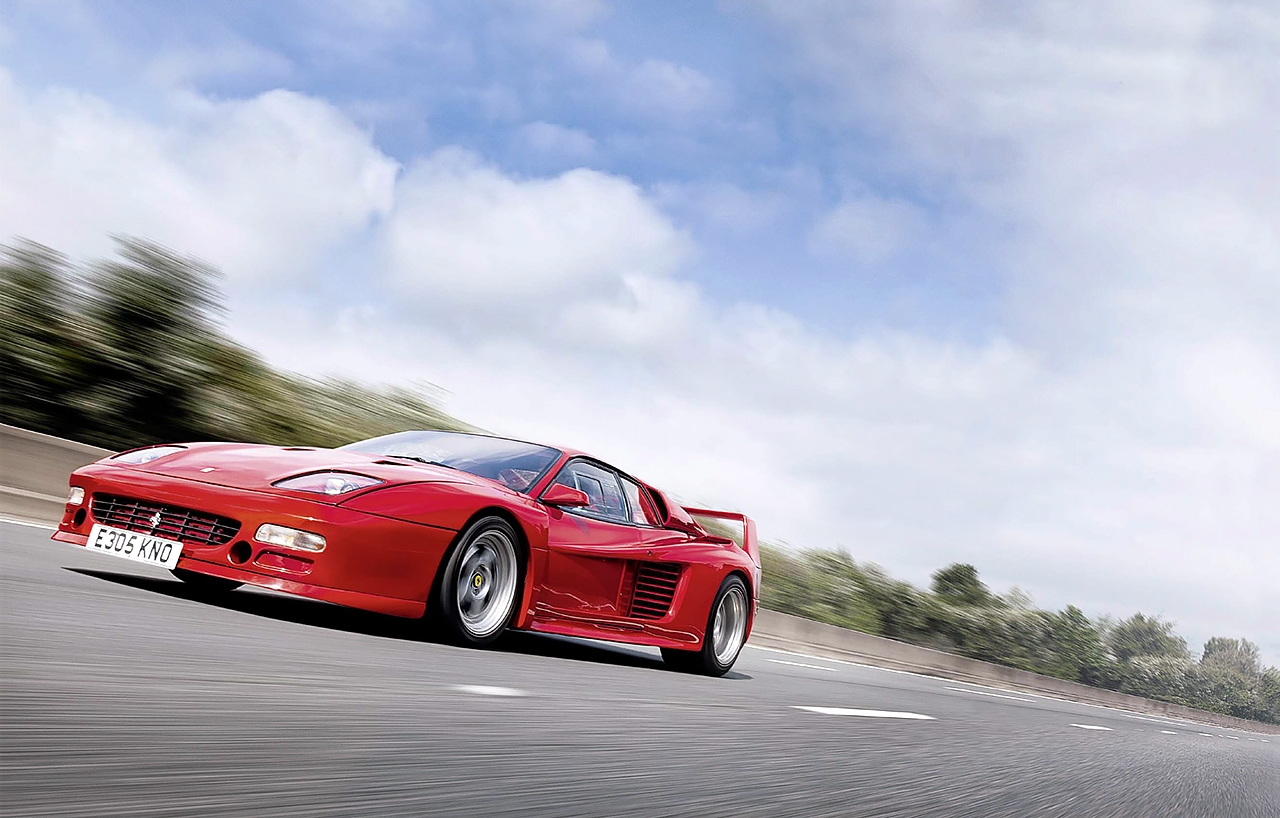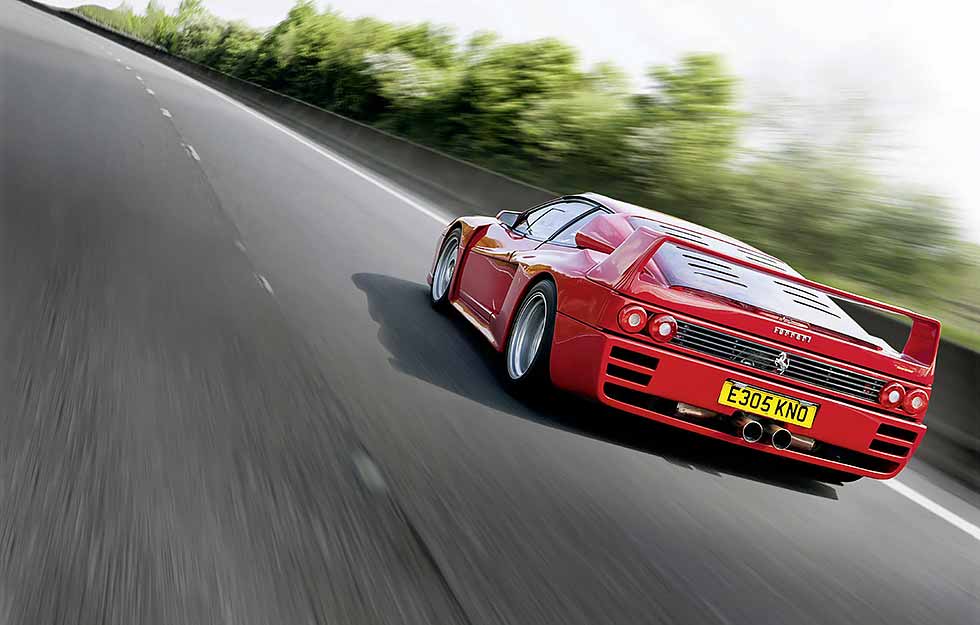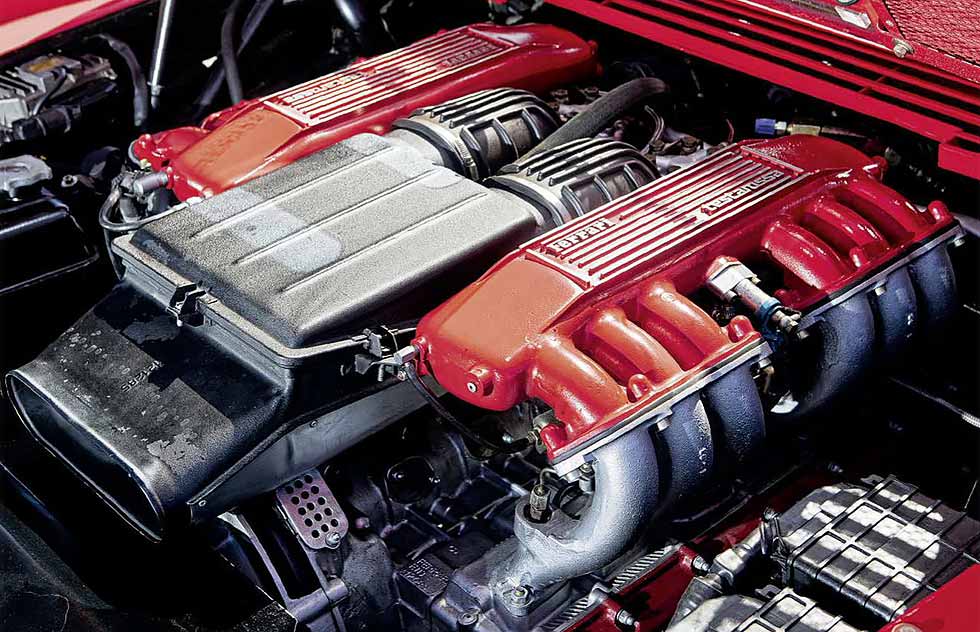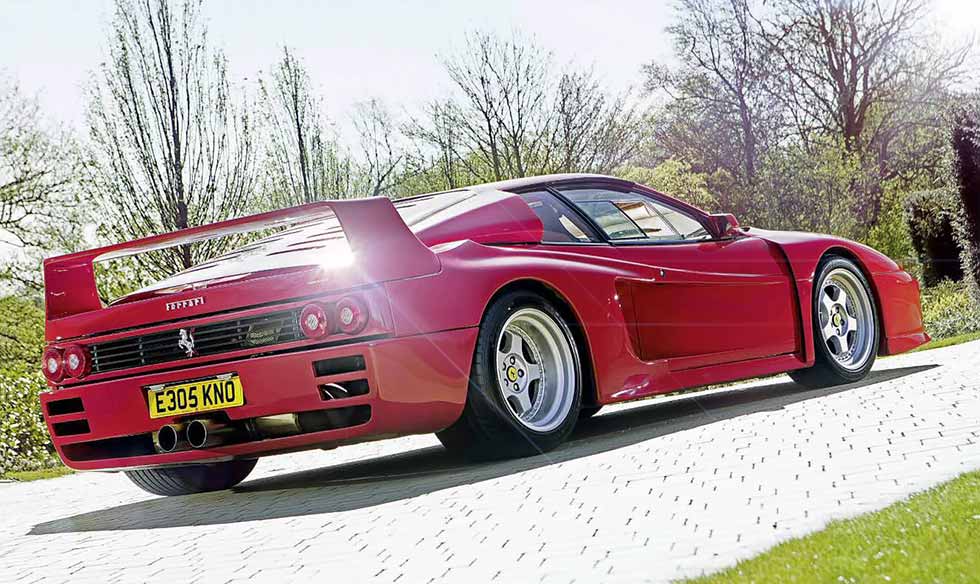
Killer redhead. Driving the ultimate 1980s bedroom poster car, the astonishing 800bhp Koenig-modified Ferrari Testarossa Competitizone. Normal Testarossa not mad enough for you? Meet the 800bhp Koenig remix. The standard Testarossa too boring ? Not ’80s enough? Don’t worry, you could plump for Koenig’s astonishing 800bhp remix. Hang on and enjoy the ride. Words Rob Scorah. Photography Neil Fraser.
ACCEPTABLE IN THE ’80S
What do men with power want? More power. So if we extrapolate that, what do men with a supercar want? More power, a body kit and an exterior colour-coded cabin. Fair enough, but what if the soon-to-be empowered supercar is already one of the most flamboyant machines to have taken to the road? Things are going to get outlandish, that’s what.
Behold the 1987 Koenig Ferrari Testarossa Competition Evolution II, the ultimate incarnation of one of the 1980s’ most potent bedroom wall stars. Depending on what angle you catch it from, you may be thinking F40, custom drag racer or 512M. The latter was a later addition by the third owner, who thought the standard Testarossa nose just too prosaic. So he sent it back to Koenig for further surgery. All this isn’t so much gilding the lily as giving it an aluminium weave stem and razor blades for petals.

The Koenig-tuned and body-kitted Ferrari Testarossa has a 320km/h (200mph) speedometer. It’s not there just for show.
In its day, the Testarossa had some stick from the old guard as being too much the poseur, a hairdresser’s car – and one without competition pedigree at that. Men who yanked the Daytona’s recalcitrant parking-speed steering with one hand sighed and shook their head. But a standard Testrossa looks relatively restrained next to this mass of ducts and spoilers. And the interior’s positively sombre.
When describing many supercars, we might gloss over the interior – but here, it’s to be celebrated. This is a symphony of excess. Open the door, and there’s a sudden rush of red – of a shade you might more expect to see in Liberace’s tour bus. When you’re sitting in it, in bright sunlight, that interior starts to glow. If, no doubt like some of Koenig’s more ‘artistic’ or hedonistic clients, you had had a few heavy or otherwise ‘interesting’ nights, you might think that some kind of psychedelic experience was kicking of behind the wheel.
In place of Ferrari’s standard, tombstone seats, there’s a pair of moulded, high-backed and shoulder-embracing structures that look like they will hold you firm when the ordinary Testa’s benches let you slide sideways when the cornering forces that this car can generate take hold. OK, we’re trying to ignore the vibrant blue ‘Koenig’ script on the four-point harnesses, (look at it long enough and the letters will burn into your retinas), but they too are an improvement on the usual same-as-a-Fiat-Uno seatbelts. And lastly, there’s the steering wheel. Thicker, slightly smaller and with moulded thumb grips. Oh, and it’s red. Very, very red.
Still, unlike the original designers, Liberace and his assistant did acknowledge that you might be generating some serious forces in this machine, and they furnished you with the body and hand-bracing tools to wrestle with it. Other than these items, the cabin is pretty standard, except for one final hint as to the nature of this thing; the speedo now goes up to 320km/h (200mph).

Looks like hell on earth, but is tractable in daily driving. Until you unleash more than half throttle – it then it makes enough force to affect the climate.
Time to drive this bespoke 1980s monster. The sun is streaming through the glass, and we’re looking between the plush stitched leather and the tiny Perspex sliding window. It’s easy to believe that this car might have some identity issues. And with ‘the glow’, we’re feeling the need for painkillers and sunglasses. And we’re not even hungover. But otherwise, we’re ready. Bring it on.
‘On’ is the usual ignition key, and start-up is a snuffling whinney, a snort. That’s then a whumf, which settles into a menacing growl of a slightly more nervous pace than the standard idle. It’s an angry-sounding car, this.
Knowing how much power has been pushed from the big horizontally-opposed 12-cylinder sitting quite high behind your right shoulder, it’s quite a surprise to feel the usual benign clutch of a Testarossa. And, like its standard cousins, the monster trots of slowly on little more than tick-over, grumbling to itself as it goes. Apart from the row, it could be a Mercedes-Benz trickling forward such is its docility. Lamborghini would have done well to take note.
As soon as you think that though, you reach down to click through the open gate, going from first – close in by your thigh – to second, forward and to the right. It’s a little stiff of course, at least until the oil warms up. Idling towards a main road, there’s time again to take a deep breath and prepare for what’s about to happen.

Standard Testarossa’s tan and black interior has been dumped for a searing shade of red. We love it.
Once again, it’s time to take stock of the super-wide bodywork, but from the perspective of the driver’s seat. The Testarossa’s standard mirrors – generally quite good ones by supercar standards – have been replaced by angular and elfish little ears. There doesn’t appear to be anyway of adjusting them. The far side one gazes into space, while the driver’s one stares down the assorted ducts of the rear pod. So we’re going to have to rely on the centre mirror, which does its best to peer out of the engine cover openings and under the F40-style rear wing.
By now, we’ve reached wide, black tarmac and the Koenig’s ready to prowl. There’s a lot that’s familiar Testarossa – the supple ride, the smooth spooling up of power. It may say ‘Competition’ on the wide door sills, but thankfully no one’s seen fit to harden up the suspension to the point of blurring your vision. Dampers and springs dismiss potholes with a far off thud. You feel nothing through the seat and the car tracks straight. The front wheels take a little notice of ruts and grooves, but a grip of the steering wheel keeps the front where you want it.
Yes, the Testarossa was a great tourer, allowing very low-input progress when you wanted it. But a quick stab of the throttle and a down-change will remind anyone that both Koenig and the Testarossa held secrets that could so easily be unleashed. The tacho needle jumps, the engine tone hardens, and, even in this weighty GT, the change in pace is immediate.
Go in too hard and you’ll hear a guttural hiss from the rear and feel a slight wiggle through the seat as the big beast’s huge rear tyres break traction under the power. Complete with tyre smoke, it’s a party piece at low speed, but really it just breaks the Ferrari’s rhythm and poise. Better to roll your heel steadily, grip tightly and hang on.

The only outfit that you’ll need when driving this car – a Miami Vice-spec pair of Chinos and linen shirt. All that’s missing are the embossed Ray Bans.
The delta-winged sled hunkers down, digs in and takes off like a jet on a steam catapult. It makes the ferocious mechanical noises you’d hope for from an 800bhp projectile. Accompanying this is a rorty yarp rises from the exhaust, while the instrument needles climb quickly through some alarming numbers. The absurdity of where you’re sitting then flashes across your awareness – the boudoir leather combined with racing seat rigidity, the reclining driving position and the shoot-from-the-hip gear change flowing all this power through the cogs.
It’s kind of automotive glam-rock. And as tight bends approach, you wonder what this sizable rig will do, though glancing this way and that to try to get any kind of framing reference from the mirrors is useless. At least you can always have confidence in a Testarossa’s steering, the nose turning in a reassuringly exact answer to the twisting of the wheel. And no matter how much lock is applied, the car seems to be tucking itself in tighter.
The body roll of the standard car has gone, presumably tied down by the heavier duty springs and anti-roll bars. The big GT’s stance is neutral, no fighting to make it turn under power, but equally little reaction if you muck around with the throttle mid-bend. Though probably best not to try that on an 800bhp Testarossa’s limits.

‘Testarossa’ means red head in Italian, making reference to the engine’s red-painted cam covers.
But it’s amazing that, despite the Ferrari in a Rocky Horror ball gown appearance, the machine just deals with anything you through at it. Autobahns – obviously. A-roads, lots of fun. B-roads, still pretty nimble.
Foolhardily, yes, it could follow a Caterham into narrow country lanes, and give it a damned good run for its money – at least until the Koenig’s rear end jammed between the hedgerows and the Caterham scurried away. Apart from the insane width, the car is a testament to both maker’s and modifier’s ability.
Of course, the Koenig is great at devouring continents with ease. You can drive from Calais to Geneva without breaking a sweat. It excels at blasting down coastal highways, its banshee wail drifting towards the mountains inland. Perhaps the greatest travesty against the car was Ferrari’s muting it with a muffling exhaust and too soft a suspension so as not to upset its plutocrat clientele. But Willy Koenig freed up the Testaroosa’s inner hooligan.
The Modern Classics view
Firstly, it’s probably worth getting the real world stuff out of the way first. The Koenig modifications – as time progresses – will probably leave this Testarossa worth less than its unmodified cousins in a market where originally means everything. It’ll be harder to sell, too, as well as maintain, should you chip its bodykit or kerb a wheel.

But does that matter when you have 800bhp at your disposal, and are driving the ultimate incarnation of 1980s bedroom wall poster excess? The Koenig is an astonishing car – it allows for you to dial in as much or as little wildness as you want at any given moment. It’s a comfortable tourer, now with added ‘vividness’.
The engine is superbly tractable, though if you plod through rush hour traffic, it takes on a ‘chorus of the damned’ moan just to emphasise its boredom. What is the ultimate satisfaction of this thing is that, with a snap of a gearchange and dab of throttle, it’s transformed.
As quick as the needles flash across their dials, the Koenig morphs from grand barque to destroyer, from elegant tourer to molten Nismo street racer. It leaves hot black tyre trails on the tarmac and its exhaust yowl scorches into the walls. And then back again – all in time for tea at the marina.
We hope the original owners of these boutique hotrods knew they are best taken with a slice of irony and a wicked sense of humour. That they should revel in these creations, but not take the whole thing too seriously. You’ll have an awful lot of fun that way.
SPECIFICATIONS
Engine 4942cc/flat-12/DOHC
Power 787bhp @ 7500rpm
Torque c.650lb ft @ 5000rpm
Performance Top speed: 218mph; 0-60mph: 3.5sec
Fuel consumption 15-20mpg
Transmission RWD, five-speed manual
WHAT TO PAY
Concours £170,000
Good £105,000
Usable £85,000
Project £35,000
Thanks to Nigel Brunt, Mentor and Silverstone Auctions (silverstone auctions. co.uk).
“It could give a Caterham a damned good run for its money – until its rear jammed between the hedges”
KOENIG SPECIALS: FROM RACER TO EXTREME ROAD CARS
The legendary or infamous (depending on how much of a purist you are) Willy Koenig was himself very a capable racer before turning to tuning. During the 1960s, he drove machines as diverse as a Formula Junior Cooper, Ferraris 250SWB and 275GTB, the Lola T70 and the Porsche 962. In 1989, he won the challenging 500km Nürburgring race in a BMW M1 E26.
Like other Prancing Horse customers before him, he became dissatisfied with his standard car’s performance, in this cars a 1974 365BB, and turned to other coachbuilders and tuners to add the spark he felt was missing. At last, in 1977, Koening opened his own tuning shop to create the cars he longed to see on the road.
Wide bodies, straked sides, gullwing doors and convertible conversions were standard fare. Twin turbochargers usually managed to grab the attention of any customers seeking that little something beyond the norm. The wildfire modifications soon jumped from Ferraris only to Porsche, Jaguar, Lamborghini and even Range Rover. Such great names as Franz Albert (tuner) and Vittorio Strosek (designer) made their contribution to these outlandish creations.
‘Go in too hard and you’ll hear a hiss from the rear and feel a wiggle through the seat as the big beast’s huge rear tyres break traction’
‘You might think that some kind of psychedelic experience was kicking off behind the wheel’





